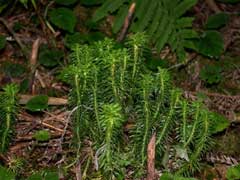 |
|
http://commons.wikimedia.org/wiki/User:Keisotyo |
 |
|
Translate this page:
Summary
Physical Characteristics

 Lycopodium serratum is a FERN growing to 0.1 m (0ft 4in).
Lycopodium serratum is a FERN growing to 0.1 m (0ft 4in).
Suitable for: light (sandy) and medium (loamy) soils and prefers well-drained soil. Suitable pH: mildly acid, neutral and basic (mildly alkaline) soils. It can grow in full shade (deep woodland) or semi-shade (light woodland). It prefers moist soil.
UK Hardiness Map
US Hardiness Map
Synonyms
Plant Habitats
Woodland Garden Dappled Shade; Shady Edge; not Deep Shade;
Edible Uses
References More on Edible Uses
Medicinal Uses
Plants For A Future can not take any responsibility for any adverse effects from the use of plants. Always seek advice from a professional before using a plant medicinally.
Antispasmodic Diuretic Miscellany Women's complaints
A decoction of the plant is antispasmodic and diuretic, it is also used in the treatment of irregular menstruation[218]. The spores of this plant are dusted on wounds or inhaled to stop bleeding noses. They can also be used to absorb fluids from injured tissues[213, 218]. The spores can be used as a dusting powder to prevent pills sticking together[213].
References More on Medicinal Uses
The Bookshop: Edible Plant Books
Our Latest books on Perennial Plants For Food Forests and Permaculture Gardens in paperback or digital formats.

Edible Tropical Plants
Food Forest Plants for Hotter Conditions: 250+ Plants For Tropical Food Forests & Permaculture Gardens.
More

Edible Temperate Plants
Plants for Your Food Forest: 500 Plants for Temperate Food Forests & Permaculture Gardens.
More

More Books
PFAF have eight books available in paperback and digital formats. Browse the shop for more information.
Shop Now
Other Uses
Miscellany Mordant Weaving
The following uses are for L. clavatum. They quite possibly also apply to this species[K]. The spores are water repellent and can be used as a dusting powder to stop things sticking together[106, 171]. They are also used as a talcum powder and for dressing moulds in iron foundries[74]. They can also be used as explosives in fireworks and for artificial lightning[46, 57, 102, 171, 213]. The plant can be used as a mordant in dyeing[172]. The stems are made into matting[46].
Special Uses
References More on Other Uses
Cultivation details
We have very little cultivation information on this species and do not know if it will succeed outdoors in Britain. The following notes are based on the general needs of the genus. Thrives in a rough spongy peat in a shady position[1]. Requires a humid atmosphere[200]. Terrestrial members of this genus are hard to establish. The roots are delicate and liable to rot, most water being absorbed through the foliage[200]. Members of this genus are rarely if ever troubled by browsing deer[233]. Although looking more like a moss, this genus is closely related to the ferns[200].
References Carbon Farming Information and Carbon Sequestration Information
Temperature Converter
Type a value in the Celsius field to convert the value to Fahrenheit:
Fahrenheit:
The PFAF Bookshop
Plants For A Future have a number of books available in paperback and digital form. Book titles include Edible Plants, Edible Perennials, Edible Trees,Edible Shrubs, Woodland Gardening, and Temperate Food Forest Plants. Our new book is Food Forest Plants For Hotter Conditions (Tropical and Sub-Tropical).
Shop Now
Plant Propagation
Spores - best sown as soon as they are ripe on the surface of a humus-rich sterilized soil. Keep the compost moist, preferably by putting a plastic bag over the pot. Pot on small clumps of plantlets as soon as they are large enough to handle and keep humid until they are well established. Do not plant outside until the ferns are at least 2 years old and then only in a very well sheltered position. The spores are generally produced in abundance but are difficult to grow successfully[200]. Layering of growing tips[200].
Other Names
If available other names are mentioned here
Native Plant Search
Search over 900 plants ideal for food forests and permaculture gardens. Filter to search native plants to your area. The plants selected are the plants in our book 'Plants For Your Food Forest: 500 Plants for Temperate Food Forests and Permaculture Gardens, as well as plants chosen for our forthcoming related books for Tropical/Hot Wet Climates and Mediterranean/Hot Dry Climates. Native Plant Search
Found In
Countries where the plant has been found are listed here if the information is available
Weed Potential
Right plant wrong place. We are currently updating this section.
Please note that a plant may be invasive in one area but may not in your area so it’s worth checking.
Conservation Status
IUCN Red List of Threatened Plants Status :

Growth: S = slow M = medium F = fast. Soil: L = light (sandy) M = medium H = heavy (clay). pH: A = acid N = neutral B = basic (alkaline). Shade: F = full shade S = semi-shade N = no shade. Moisture: D = dry M = Moist We = wet Wa = water.

Expert comment
Author
Thunb.
Botanical References
Links / References
For a list of references used on this page please go here
Readers comment
© 2010, Plants For A Future. Plants For A Future is a charitable company limited by guarantee, registered in England and Wales. Charity No. 1057719, Company No. 3204567.